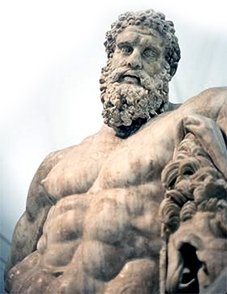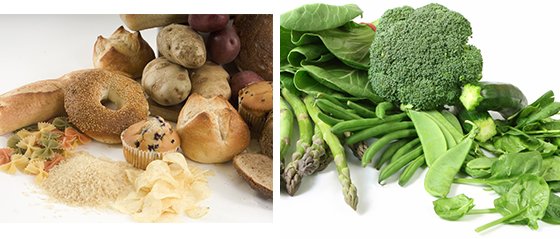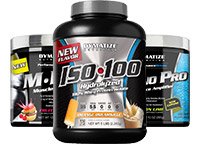I can't tell you how many times I've had people ask me some variation of this seemingly simple question over the years: "Which food and supplements should I eat to build muscle while minimizing collateral gains in body fat?" It's happened enough that eventually, I started analyzing the question itself, hoping to find a better way to approach it. In most cases, I've found that what seems to be a straightforward inquiry was actually several more complex questions rolled into one.
Here's how the discussion usually progressed ... I would begin with an overview of the key foods and supplements, as well as how much to structure them based on research studies. Inevitably that would lead to a question or two about nutrient and supplement timing, which in turn would lead to a much more extensive discussion about putting all the components together into a unified, duplicable daily nutrition plan.

If only the confusion ended there. More often than not, I found that the way we traditionally approach key nutritional concepts holds us back from making real progress. The focus on calories at the expense of hitting nutrient targets is probably the biggest problem. The simplistic way in which many people interpret macronutrients sets them up to fail.
If you are looking for a more straightforward way to quantify and interpret your intake of protein, carbs, and fats, I've got it. Rather than get bogged down in calories, I'm going to lay out a muscle-building meal plan designed around protein and classifying other macronutrients on how your body actually uses them.
Protein Beyond the Grams
We can begin by taking a cue from the ancient Greeks and make protein our first priority. The term protein is actually derived from proteios, which means "the first quality" or "first." How can you argue with the civilization that gave us Hercules and Zeus?

Protein is indeed the right starting point for developing a muscle-building nutrition strategy, especially when you recognize that it makes up more than 80 percent of the dry weight of muscle.1 Just as important, protein is the most filling and the most thermic, or calorie-burning, of the energy nutrients. For these reasons, you're going to plan around protein, making it the basis of every meal. Begin eating protein early in the day and end with it late at night.
If you train intensely, I recommend targeting 1 g of protein per pound of body weight to cover your needs for muscle growth and maintenance. This level is a little higher than the upper end of the 1.4-2.0 g/kg range recommended by the International Society of Sports Nutrition (ISSN) for protein needs based on performance and muscle adaptation resulting from training. I say you could even go above 1 per pound if your food volume and lifestyle allow. Daily protein intakes in excess of 150-200 g are not uncommon among hard-training women and men.
In order to keep things simple with so many grams of protein, I prefer to think beyond the small numbers. I designate food portions that deliver 25 grams of protein as a protein-rich offering, or PRO. So 200 g of protein would be 8 PRO, for instance. This system allows you to more easily spread your baseline protein needs among your daily meals.
How to Plan Like a PRO
I'm more flexible than some people about the number of meals in a day. Only three are non-negotiable: breakfast, post-workout, and evening. Your decision to eat four, five, or six meals per day is a matter of preference and lifestyle. Simply recognize that fewer meals mean more protein per meal. If the gap between meals is going to be greater than 3-4 hours, you're going to follow it with a protein-rich meal containing at least 2 PRO, or 50 g of protein.
25 g of protein = 1 PRO (protein-rich offering)
Let's take a look at how this could play out for a 190-pound male weight trainer. He could eat 2 PRO during breakfast at 7 a.m., train from 4-to-5:30 p.m. and then have a 2-PRO post-workout meal at 6 p.m. and a protein nightcap of 1 PRO at 10 p.m. Those three meals put him approximately halfway to his 8-PRO target for the day, with a large gap in the middle of the day to customize around his needs and goals. He could easily add in a sizeable meal containing approximately 3 PRO late in the morning and smaller meal of 1 PRO about 60 minutes before training. Alternately, he could plan for two moderate meals containing approximately 2 PRO apiece in between breakfast and training.
Regardless of the number of meals he eats, the objective is to keep a consistent flow of amino acids circulating to muscle, which is where the real benefit of thinking of PROs rather than grams becomes apparent. Researchers have shown that a single, large dose of protein, at least 25 g, drives muscle protein synthesis (MPS) more effectively than spreading out the same level of protein over a few hours.2
Leucine for Maximum Muscle Protein Synthesis
Both resistance training and high-intensity interval training stoke MPS, and this effect can last a day or longer. So how do you keep the signal for MPS amplified as high as possible and for as long as possible? Getting your PROs is one way. Adding leucine into the mix is another.
The most significant signal that is stoked by hard exercise is what's known as the mTOR signaling pathway. Leucine, one of the three branched-chain amino acids, is thought to directly act on mTOR and trigger an optimal level of MPS signaled by mTOR, particularly in combination with exercise and consistent protein intake.3
But how much leucine is needed? Researchers now think that at least 2 grams are needed to trigger higher levels of MPS for smaller individuals and higher levels, maybe up to 4 grams, for larger, more muscular individuals. For our purposes, aim for at least 2.5 g of leucine at each meal if your meals are more than 4 hours apart. For meals that are closer than that, include at least 2 grams. Supplemental leucine is one way to get this, but there are plenty of food sources as well.
PRO units and Leucine Content for Foods
Food |
Serving size: 1 PRO |
Grams of Leucine |
| Whole egg | 4 | 2.0 |
| Egg whites | 7 | 2.3 |
| Poultry/pork/beef* | 4 oz. | 2.5 |
| Fish | 4 oz. | 2.5 |
| Skim milk | 3 cups | 2.5 |
| Greek yogurt | 1.5 cups | 2.5 |
| Lentils | 1-3/4 cups | 2.25 |
| Whey or casein supplement | 1 serving | 2.5 |
| 2:1:1 BCAA supplement | 5 g | 2.5 |
| * Depending on cut and leanness | ||
Carbs: Think Energy and Functional
The prevailing carbohydrate categories of "complex" and "simple" have their uses, but when the goal is altering body composition, there's a more effective way to approach this macronutrient.
Typically I break carbohydrates into two general types based on how the body utilizes them. The first types serve as energy resources, either immediately or when stored as glycogen. I call these E-carbs. They deliver quick energy in the form of starches and sugars and include breads, pasta, rice, potatoes, and fruit juices.
The second types serve more functional roles like slowing digestion, supporting satiety and fullness, and delivering additional nutrients such as vitamins and minerals. These are F-carbs, which include fiber-rich foods such as green vegetables and legumes.

Of course, some foods straddle the line between the two categories, such as whole grains, which are dense in both fiber and starch energy. Fruit likewise delivers both fiber and energy. I consider both of these to be E-carbs, but healthier ones than other E-carbs. It's worth remembering that fructose is the main sugar in fruit, and as such, the majority of carbs derived from fruit are used to restock liver glycogen rather than serving as muscle fuel.4
Typically I don't recommend restricting F-carbs. E-carbs, on the other hand, are going to be most important in the morning and in association with a training session. In the morning, E-carbs raise insulin levels to help halt the breakdown of muscle proteins that occurs during sleep. Plus, they will help replenish glycogen stores in muscle tissue prior to the upcoming workout, with the rest getting deposited in the liver. By extension, taking in E-carbs before, during, and after training allows them to help fuel muscle during training and once again restock muscle carbohydrate stores.
At other times during the day, E-carbs should be tapered back significantly. In these periods use more F-carbs, perhaps alongside some of the healthier E-carbs, to round out meals, increase volume and help promote fullness.
Burn Fat For Function and Fuel
As with carbohydrates, I classify fat sources as either an energy fat, or E-fat, and functional, or F-fat. E-fats include most vegetable oils, as well as the saturated fat typically found in animal meats and dairy. F-fat comes from fish, avocado, coconut oil, nuts, egg yolks, and olive oils.
E-fat-heavy foods are best consumed post-workout, when more of the fat they contain can be utilized by muscle cells rather than deposited as adipose tissue. In most other cases, these fats should be minimized by avoiding butter or margarine, removing skin from poultry, choosing low-fat dairy, and limiting snack foods made with oils such as soybean and corn oils. F-fats can be more broadly integrated into a diet, due to their crucial nutritional functions.
Strategic Supplementation
Given that I'm advocating you approach protein 25 g at a time, it's probably a relief when I say protein supplements can be used at any meal. However, not just any old protein will do. Pay special attention to the protein type and amino acid composition, not just the total protein on the nutritional label.

Whey is fast-digesting, and casein is slow-digesting. For this reason, the whey:casein ratio can be used as a meal timing tool. Protein supplements that are all whey and no casein are better first thing in the morning and around training, while a product with a greater percentage of casein can be used strategically to help control hunger during the day or for more protracted amino acid delivery at night. Both whey and casein are leucine-rich, but feel free to use BCAAs or leucine supplements to drive up leucine intake at meals throughout the day.
Other key supplements for muscle-building include creatine, fish oil, and beta alanine. Creatine increases the level of creatine phosphate in muscle, which in turns supports strength gains and muscle volumization. It also could help muscle cells get bigger and more metabolic by supporting the fusing of satellite cells to trained muscle cells. Fish oil's omega-3 fats support a lower inflammatory response to intense training and thus can promote a speedier recovery. Plus the omega-3 fats seem to interact directly with mTOR pathway and help optimize MPS when protein and carbohydrates are consumed.5 Meanwhile, beta-alanine helps buffer lactic acid from muscle cells during intense training, which in turn can help you train harder.
All of these supplements can be split throughout the day, although I definitely recommend taking them with food either before or after training, when blood circulation to muscle is elevated. In addition, I always recommend a good general multivitamin that contains at least 100 percent DV of crucial vitamins and minerals.
The New Macronutrients Meal Plan
This example meal plan is designed for a 200-pound man targeting at least 8 PRO per day, and who trains around 4 p.m. It could easily be scaled up or down for different body types and goals. Although the plan doesn't focus on calories, the total is between 3,000-3,500 calories, with protein making up 30-35 percent of the total. If you train more than 2 hours each day and aren't looking to lean down, include more E-carbs.
Here's the way the day breaks down in terms of nutrient targets:
Meal 1
PRO: ≥2
E-carb: ≥75 g
F-fat: liberal consumption
Supplements
Meal 2
PRO: ≥2
F-carb: liberal consumption
E-carb: ≥75 g
Supplements
Meal 3
PRO: ≥1.5
E-carb: ≥ 25 g
Meal 4 (Post-workout)
PRO: ≥3
E-carb: ≥75 g
F-carb: liberal consumption
F-fat: liberal consumption
Supplements
Meal 5
PRO: ≥1.5
Got the general idea? Here's an example of how that day could look on the plate, assuming that you would spread your supplementation across the day rather than consuming it all around your workout.
Omelet
 Whole Eggs
Whole Eggs
3 eggs Egg Whites
Egg Whites
7 whites Tomato
Tomato
1 tomato Mushroom
Mushroom
1 mushroom Salsa
Salsa
 Oatmeal
Oatmeal
2 cups Mixed Fruit
Mixed Fruit
2 cups
 Coffee or Water
Coffee or Water
2 cups Creatine
Creatine
2 grams Beta-Alanine
Beta-Alanine
1 gram Fish Oil
Fish Oil
1 gram Multivitamin
Multivitamin
 Chicken
Chicken
10 ounces Whole-Grain Toast
Whole-Grain Toast
 Green Salad
Green Salad
with Avocado and Olive-oil dressing Red Beans with Rice
Red Beans with Rice
 Creatine
Creatine
2 grams Beta-Alanine
Beta-Alanine
1 gram Fish Oil
Fish Oil
1 gram
 Whey Protein
Whey Protein
1 scoop Skim Milk
Skim Milk
10-12 ounces Creatine
Creatine
2 grams Beta-Alanine
Beta-Alanine
1 gram
 Grilled Tuna
Grilled Tuna
10 ounces with lemon and Tony Chachere's seasoning Green Salad
Green Salad
with Avocado and Olive-oil dressing Brown Rice
Brown Rice
2 cups Chopped Broccoli
Chopped Broccoli
1-1/2 cups
 Banana and Strawberry Slices
Banana and Strawberry Slices
2 cups Skim Milk
Skim Milk
16 ounces Creatine
Creatine
2 grams Beta-Alanine
Beta-Alanine
1 gram Fish Oil
Fish Oil
1 gram
References
- Wildman REC, Miller BS, & Wilborn C (2014). Sports & Fitness Nutrition, 2nd ed. Dubuque, IA: Kendall Hunt Publishing.
- West DW, Burd NA, Coffey VG, Baker SK, Burke LM, Hawley JA, Moore DR, Stellingwerff T, & Phillips SM (2006). Rapid aminoacidemia enhances myofibrillar protein synthesis and anabolic intramuscular signaling responses after resistance exercise. Am J Clin Nutr, 93, 795-803.
- Pasiakos SM, McClung HL, McClung JP, Margolis LM, Andersen NE, Cloutier GJ, Pikosky MA, Rood JC, Fielding RA, & Young AJ (2011). Leucine-enriched essential amino acid supplementation during moderate steady state exercise enhances postexercise muscle protein synthesis. Am J Clin Nutr, 94, 809-18.
- Décombaz J, Jentjens R, Ith M, Scheurer E, Buehler T, Jeukendrup A, Boesch C (2011). Fructose and galactose enhance postexercise human liver glycogen synthesis. Med Sci Sports Exerc, 43, 1964-71.
- Smith GI, Atherton P, Reeds DN, Mohammed BS, Rankin D, Rennie MJ, & Mittendorfer B (2011). Omega-3 polyunsaturated fatty acids augment the muscle protein anabolic response to hyperinsulinaemia-hyperaminoacidaemia in healthy young and middle-aged men and women. Clin Sc, 121, 67-78.

